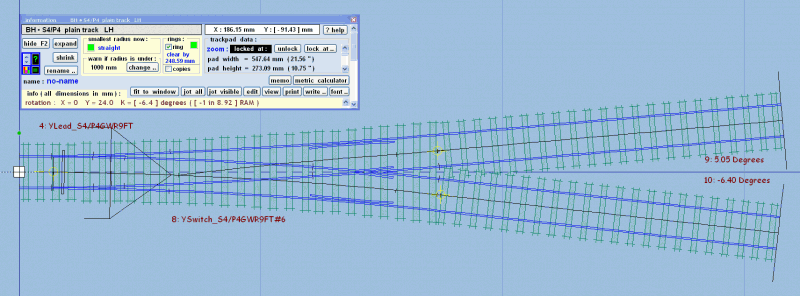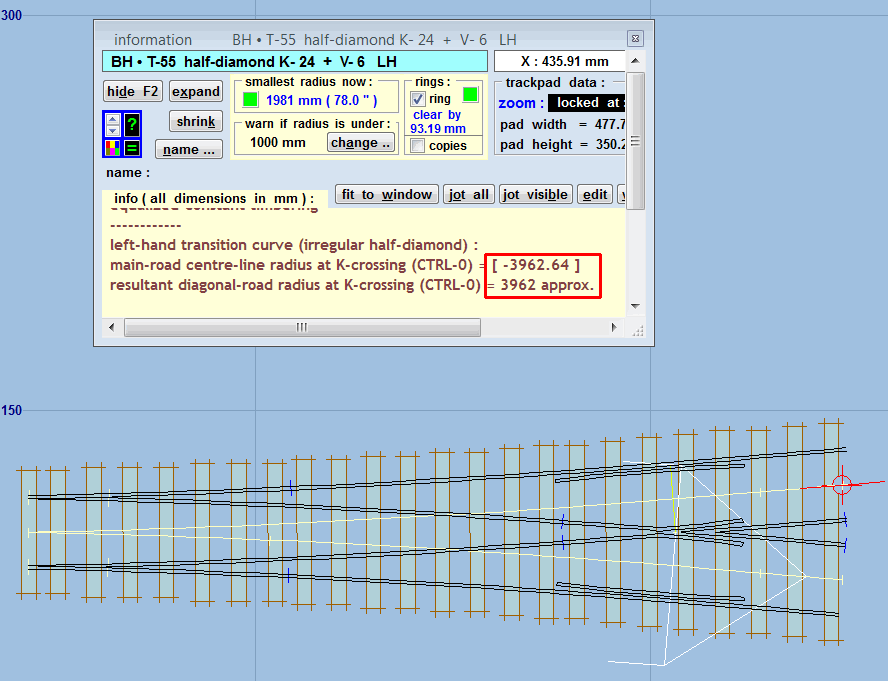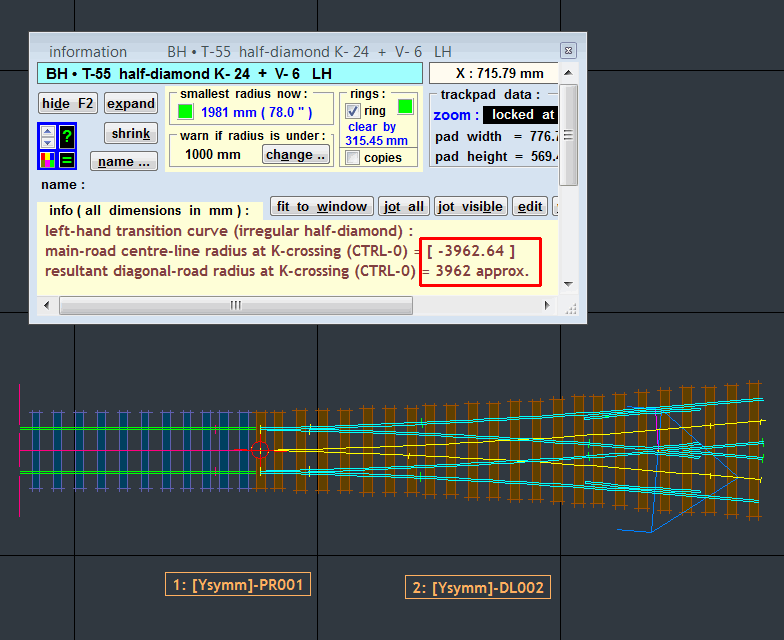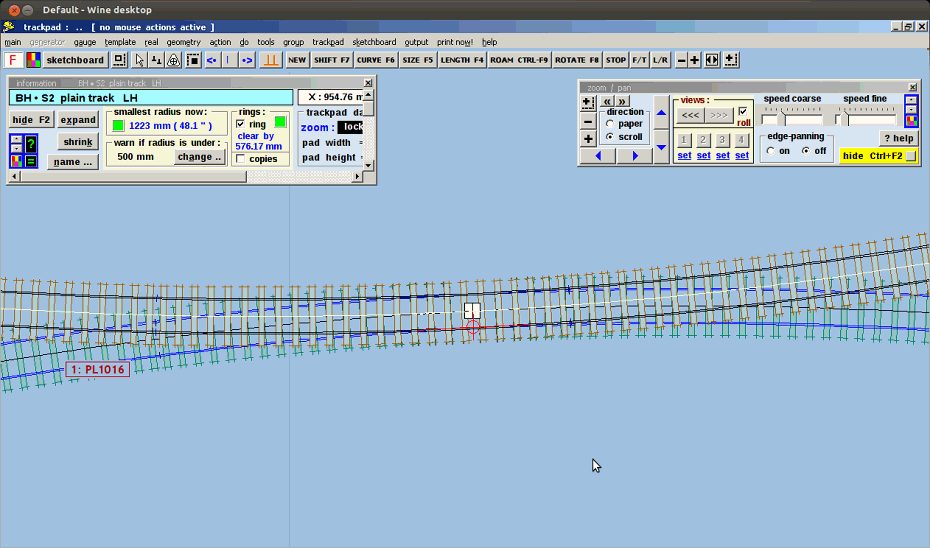Templot Club Archive 2007-2020
|
|||
| author | remove search highlighting | ||
|---|---|---|---|
|
posted: 28 Jul 2012 04:38 from: Mark C
click the date to link to this post click member name to view archived images |
Folks, I am a novice to Templot and am interested in Y Turnouts for a compact American HO shelf switching layout based on John Allen's Timesaver Puzzle, see below. Obviously, this is not prototype inspired. 2480_272315_180000000.png  For anyone interested, Google "John Allen Timesaver" to get learn more on this fascinating concept. I have not yet gone through the 2001 tutorial and your 2008 update for building Y Turnouts. In the meantime, I have created a trackplan using HO NMRA #4 model turnouts instead., see screenshot below. 2480_272320_040000000.png  I'm sure I have made a lot of mistakes in this design, but it looks like it should work. Attached is the Box file for this trackplan. Any advice on how this could be improved would be appreciated. Any advice on how to get started with a more accurate rendition of the Allen's Timesaver trackplan would also be appreciated. Is there any news on when Symmetrical Y Turnout Templates might be included in Templot? Thanks. Mark C |
||
| Attachment: attach_1477_2036_timesaver_ho_no4_2012_07_27_0345_52.box 293 | |||
|
posted: 28 Jul 2012 12:57 from: Martin Wynne
click the date to link to this post click member name to view archived images |
Mark C wrote:Is there any news on when Symmetrical Y Turnout Templates might be included in Templot?Hi Mark, Sorry, there is no news on this at present. It requires a significant rewrite of a large chunk of the generator. For not much real gain, because in truth symmetrical Y-turnouts are really quite rare on the prototype, at least in the UK. At present they can be created using the methods in this ancient tutorial: http://www.templot.com/martweb/y_symm.htm and since that was written there is now also the option of using a modified irregular half-diamond template as a symmetrical turnout. This produces a better timbered result than the method in the tutorial. Or for a more rigorous approach a symmetrical Y can be created entirely from partial templates. All that being so, the incentive to rewrite the switch generator for full split-switch adjustment has rather fallen away. Nevertheless, Templot ought to have such a capability if only for the sake of completeness, and I hope one day to add it. It's been promised for too long. regards, Martin. |
||
|
posted: 28 Jul 2012 18:53 from: Mark C
click the date to link to this post click member name to view archived images |
Martin, Thanks for the reply. I figured that was the case, but I just wanted to check. I guess I'll just have to consider going back and forth between the 2001 tutorial & 2008 post as a good learning experience. In the diagram of what I want to do, it shows a #6LH turnout off the main line (top), the straight leg of a #6RH turnout (effectively a straight piece of plain track), then a #3 Y. Since the left branch of the #3 Y would actually be a #6L (from center-line parallel to the main line), I would assume this would effectively create a parallel crossover. However, I tried to build a #3 Y from a #4LH Curviform NO NMRA template using the "Approximate" method described in the 2001 tutorial and the resulting approach track to the #3 Y wasn't parallel with the Main line track. Is this to be expected when using the "Approximate" method or must I have done something wrong? Mark C |
||
|
posted: 28 Jul 2012 19:32 from: Nigel Brown click the date to link to this post click member name to view archived images |
Hi Mark Haven't come across the Timesaver before. I quite like your straight turnout version. You say it doesn't follow prototype practice, but I could quite imagine this sort of thing turning up in a local freight yard or dockside situation. Cheers Nigel |
||
|
posted: 29 Jul 2012 06:12 from: Mark C
click the date to link to this post click member name to view archived images |
Martin, I went through the 2008 revision to the 2001 "Improvisation" tutorial on Symmetrical & Turnouts and thought I did quite well. I even think I understand most of what I did. However, in testing the two branch lines, I found that they are not perfectly symmetrical. The screen shot, below, shows my S4/P4 Symmetrical Y with a piece of straight track joined to the end of each branch line. I then looked at the rotation angle of each straight track and renamed those templates with the rotation angle. 2480_290100_250000000.png  As you can see one is 5.05 degrees above horizontal and the other is 6.40 degrees below horizontal. I zoomed in as far as I could and lined up the Fine-Point Marker as close to the horizontal line as I could. I even joined another straight to the TP and it's rotation angle was exactly 0 degrees. Is this amount of error impossible to avoid or did I mess something up? My next question will be what happens when I try to create a #3 Y for my Timesaver trackplan? Will the sharper angles magnify this error? Mark C |
||
|
posted: 29 Jul 2012 12:17 from: Martin Wynne
click the date to link to this post click member name to view archived images |
Hi Mark, I'm intending to delete the old Y-turnout tutorials because it is now much better to start from an irregular half-diamond when improvising. It's also not too difficult to create a proper symmetrical turnout using partial templates. Essentially it is a 3-throw turnout with the middle road removed. You don't need a #3 Y because that will have a very tight radius (and to match two #6 RAM it should actually be #2.92 RAM). Use a longer V-crossing angle with curviform type crossing to give #2.92 at the exit, not at the V-crossing (frog). I will post more about all this later. regards, Martin. |
||
|
posted: 29 Jul 2012 17:50 from: Mark C
click the date to link to this post click member name to view archived images |
Martin, Thanks for the reply and update. I think I understand your cryptic jargon. I'll have to experiment with it. While I like the look of the Y turnout trackplan, I may hold off until you have new instructions. I think I have a workable trackplan using #4 straight turnouts and that's probably what I'm going to build first. It would be nice if you could keep me posted when you are able to update instructions for symmetrical Y turnouts. Thanks again. Mark C |
||
|
posted: 29 Jul 2012 22:30 from: Les G click the date to link to this post click member name to view archived images |
Mark C wrote:
Hi Mark, There is no need for Martin to respond directly to your request, he already has put a facility into the forum... All you need to do is select the "watch topic" button (below left) The system will then send you an email when there is a new entry to the topic, regards Les G |
||
|
posted: 29 Jul 2012 22:40 from: Mark C
click the date to link to this post click member name to view archived images |
Thanks, Les. I forgot about that. I already do get emails when there is a new post to this topic. Mark C | ||
|
posted: 1 May 2014 20:16 from: pointo1d
click the date to link to this post click member name to view archived images |
Hiya Martin , You say in an earlier post (the 6th in this thread) that '...there is now also the option of using a modified irregular half-diamond template as a symmetrical turnout.' - would you happen to have a description or short vid to hand ? I have tried, without any success, to cheat by attempting to create a crossing at the intersection of 2 inverted curves - although TDV does find the intersection it neither constructs a crossing or generates an error - is this usaul/expected behaviour ? TIA , Dave P |
||
|
posted: 2 May 2014 01:38 from: Martin Wynne
click the date to link to this post click member name to view archived images |
pointo1d wrote: You say in an earlier post (the 6th in this thread) that '...there is now also the option of using a modified irregular half-diamond template as a symmetrical turnout.' - would you happen to have a description or short vid to hand ?Hi Dave, Sorry, no video. But it's fairly straightforward: 2_012008_480000000.png  2_012009_150000000.png  Start with a turnout of the required V-crossing angle, and some approach track. This was a B-6. Split off the approach track for use as the switch front. Convert the turnout to a half-diamond. Set the K-crossing angle to something appropriate as a switch deflection angle -- for the above I set the K-crossing angle to 1:24 (same as a 9ft or A switch). Change to a generic type V-crossing. Set a zero-length transition to straight at the MCP position. Adjust the curving (F6) of the 1st radius until it matches with the diagonal radius. Rotate the template on CTRL-0 by half the K-crossing angle. Roll the rails in the plain track template to provide a suitable switch front -- usually 2 timbers to the joint. Widen those to timber width in the shove timbers. Group the two templates and give them a suitable tag so that you can regroup them as required to use them. I hope you can follow that. I have tried, without any success, to cheat by attempting to create a crossing at the intersection of 2 inverted curves - although TDV does find the intersection it neither constructs a crossing or generates an error - is this usaul/expected behaviour ?TDV (Templot Development Version) is now out of date -- please download and install the latest version 209a: message 10771 If you have crossed two plain tracks (one as the control template) click peg/align tools > make diamond-crossing at intersection on the other one. This will set curviform V-crossings for the half-diamonds. Delete the unwanted one. If those are the required exit tracks, you won't need to rotate the turnout -- rotate the switch front instead. Use the new CTRL+F12 function to reduce the turnout road to the shortest possible and ignore the minimum radius showing (it is likely to relate to the non-existent TVJP position). regards, Martin. |
||
|
posted: 2 May 2014 17:42 from: pointo1d
click the date to link to this post click member name to view archived images |
I'm struggling on with the first bit, but in the mean time the newly attached screenshot shows the result of attempting to use the peg/align tools > make diamond crossing at intersection option on the background template between 2 inverted curing tracks - representing, as they do, the required curves into and thru the Y turnout - the yellow circle does briefly appear over the notch, then disappears, leaving what you see before you. It possibly ought to be noted that the peg has been moved whilst I was attempting to use it to discover the angle at the where the FP would be. I'm guessing that it might have something to do with the tracks being tangential i.e. not actually crossing. 2_021353_340000000.png  |
||
|
posted: 2 May 2014 17:58 from: Martin Wynne
click the date to link to this post click member name to view archived images |
Hi Dave, You can't make a diamond-crossing there because the tracks don't actually, er, cross. Instead, try this method based on the rail intersection: http://templot.com/companion/index.html?fit_turnout_to_existing_curves.htm regards, Martin. |
||
| Please read this important note about copyright: Unless stated otherwise, all the files submitted to this web site are copyright and the property of the respective contributor. You are welcome to use them for your own personal non-commercial purposes, and in your messages on this web site. If you want to publish any of this material elsewhere or use it commercially, you must first obtain the owner's permission to do so. |